Chillies (Capsicum) are characterised by their more or less pungent flavour depending on the variety. They are used as a condiment to liven up dishes. These fruits “that bite when you bite them” contain an extremely powerful alkaloid (capsaicin), which makes them more or less hot on the palate. There are five main species whose colour varies by variety from red to green via yellow. While the mildest can be eaten fresh, most are dried and ground into powder. Drying allows them to be stored for years without altering either their flavour or their heat. So if you have a chilli plant in the garden, dry them! Here are the different methods (on string, in the oven, in the sun) to dry your chillies as well as our tips for storing them properly and using them in the kitchen.
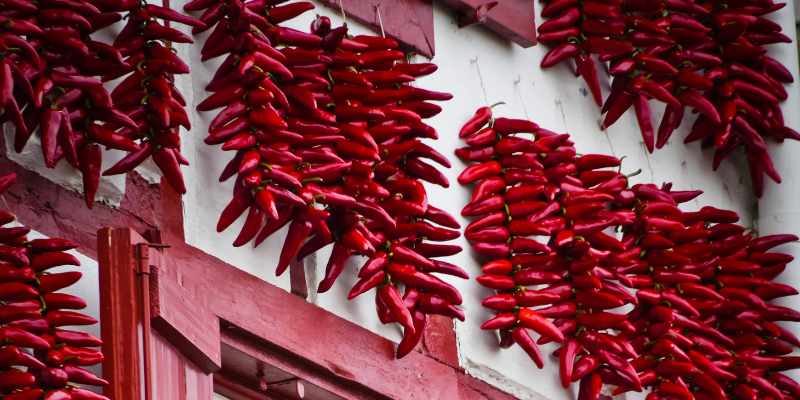
Chilli varieties for drying
All chilli varieties are suitable for drying. It’s a matter of taste and colour. The mildest will suit sensitive palates. Choice of variety will depend on your heat tolerance! Some show caramel notes, others fruity or herbaceous notes. Bear in mind that chillies gain in heat as they dry…
- The ‘Purple’ chilli is a hot variety that produces fleshy, dark purple fruits.
- The ‘Red Cherry small’ chilli or ‘Turkish Ball’ chilli yields bright red chillies resembling cherry tomatoes, with a strong flavour (6/10 on the Scoville scale).
- The ‘Sucette de Provence’ chilli produces long, slender fruits with a fiery flavour.
- The Cayenne pepper, also known as Piment enragé, is one of the hottest in the world with a burning flavour (rated 6/10). It produces numerous elongated, scarlet-red fruits.
- The Anaheim chilli is a mild chilli whose elongated fruits have a warm, fruity flavour, rated 2/10 on the Scoville scale.
- The Hungarian 'Yellow Wax Hot' chilliforms attractive elongated, pointed fruits that turn from green to yellow then red at ripeness and have a heat comparable to Tabasco®.
- The ‘Tomato’ chilli produces red, fleshy fruits reminiscent of beefsteak tomato.
- The Espelette chilli (Basque piment Gorria) is traditionally grown in Basque Country. Its long red chillies reveal a warm, delightfully piquant flavour, rated 4/10.
- The Habanero is ranked among the 10 hottest chillies in the world! Its small explosive fruits (10/10 on the Scoville scale) take the shape of scarlet lanterns when ripe.
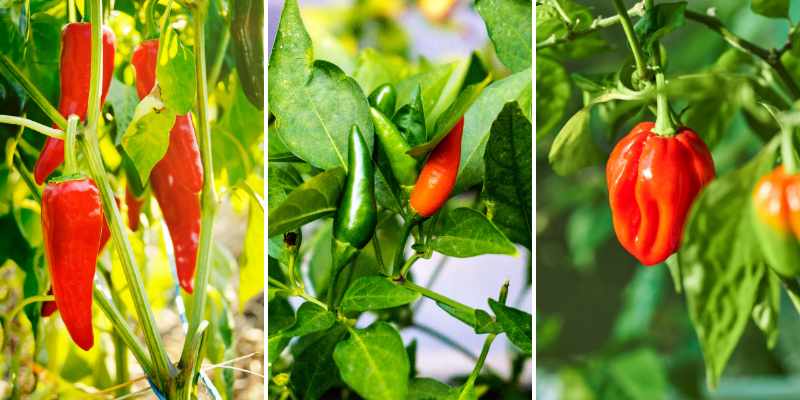
Why dry your chillies?
Chillies only keep for about a week in the fridge vegetable drawer or six months in the freezer. Depending on your yield, you will very likely want to store them for longer. Thanks to drying, they will keep for several years without losing their flavour or heat. So to enjoy them all year round, drying is an ideal solution. Once dried, they also become more potent!

When and how to harvest your chillies?
Chilli harvest takes place from August to October. Pick them when fully ripe and the skin is smooth so they develop their full flavour. Cut the fruits using a pair of small scissors or a small knife, leaving 1 to 2 cm of stalk. Chillies continue ripening after being picked. For a successful harvest:
- pick them when they have reached their final colour (red, green, yellow, orange, etc.)
- test firmness: a ripe chilli should be firm to the touch, neither hard nor soft
- inspect them: they should be healthy with no signs of mould or any unpleasant odour
How to dry your chillies?
There are several methods to dry your chillies properly. After drying, chillies should be evenly dry but not rock-hard; they should remain fairly supple. Once well dried, you can either grind them into powder or keep them whole.
Preparation
- Put on gloves before handling chillies, as mere contact can cause burning if you rub your face
- Before drying, wash them in clean water
- Dry the fruits in a clean cloth or on paper towels to remove as much water as possible and speed up drying.
In the sun, naturally
Sun drying is an effective method if you live in a sunny region. However, in our country at harvest time, between August and October, it is rather late in the season. Sunlight may be insufficient, because a good drying requires a temperature of 25 to 30 °C for several days, even a week. If conditions allow, lay whole chillies on a tray, a clean cloth or a rack so they do not touch and expose them directly to the sun. Cover them with a mesh to protect from insects and dust. Turn them regularly to ensure even drying. Make sure they are sheltered from rain and humidity. This method can take from 1 to 3 weeks, depending on weather conditions. Bring them indoors at night to protect them from evening humidity.
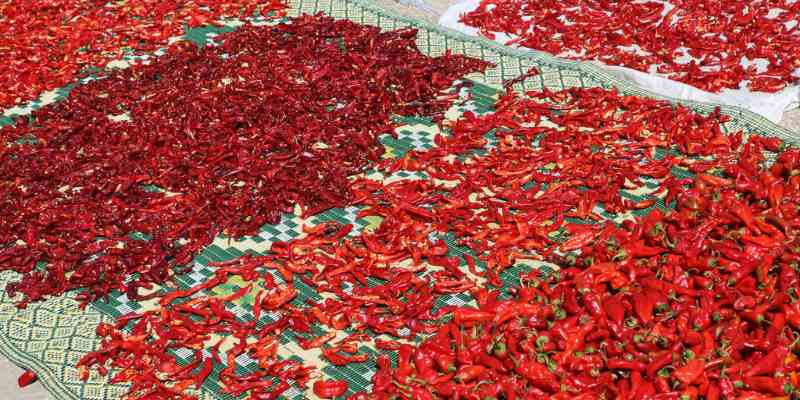
Air-dry them indoors
In less sunny regions, after harvest, hang them in bunches by a string in a dry, warm room (minimum 20 °C) with good sunlight so moisture can evaporate. You can dry chillies behind a window. The room should be well ventilated. Drying can take around three weeks for the chillies to be dry. Turn the chillies regularly.
On string
The advantage of this traditional method is that you do not need to handle the chillies every day to turn them. Chillies should neither be sliced nor destemmed. Thread the chillies onto a string using a needle pierced through the stalk and hang this garland in a dry, well-ventilated place. Space the chillies to allow air circulation. Leave them to dry for 3 to 4 weeks. This method preserves flavours well, but it is longer than the others.
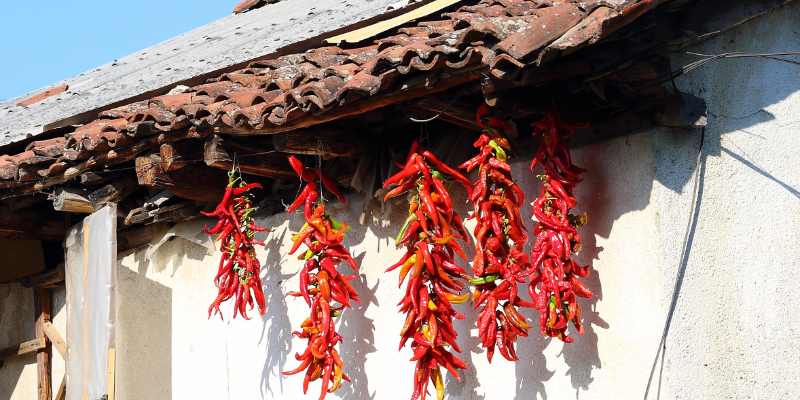
In the oven
This drying method is not the most economical but is a good option in regions lacking sun to achieve proper drying. The aim is to remove the water from the fruits as gently as possible, without cooking them. Preheat the oven to 50–60 °C (or to 40 °C if using a fan oven). Cut the chillies in half lengthways and remove the seeds if you wish. Place the chillies on a baking tray lined with baking paper, ensuring they do not touch. Leave to dry for 8 to 12 hours, leaving the oven door slightly ajar (close it after 2 hours) to allow moisture to escape, turning the chillies every hour. The larger the chillies, the longer the drying time.
In a dehydrator
Chillies can be dried in a dehydrator. This method, less energy-intensive than an oven, allows dehydration at low temperature. Refer to your appliance manual; drying can take between 12 and 24 hours.
How to store homemade dried chillies?
Once dried, chillies should be stored away from air and light to preserve their flavour and freshness. Here are some tips for storing your dried chillies:
- store whole or broken chillies in airtight glass jars or in zip-lock plastic bags.
- keep chillies in a cool, dry place away from light to preserve their colour and aroma.
- for longer storage, you can also grind them to a powder using a coffee grinder or a mortar and pestle and keep in airtight containers. This method intensifies chilli flavours and allows very long storage. You can incorporate this chilli powder into a spice blend.
- dried chillies can be kept for several years if well stored, but their flavour diminishes over time. It is therefore recommended to use them within a year of drying.
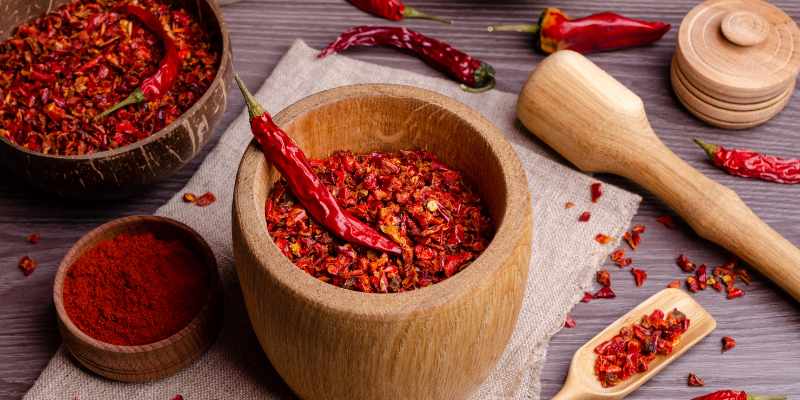
How to use dried chillies?
Do not touch your eyes after handling chillies without thoroughly washing your hands. Dried chillies are used as condiments to flavour and spice hot dishes (a chilli con carne or vegetarian chilli, a vegetable or fish dish, stuffings, a soup), cold dishes (sauces, spreads, dips…), sweet dishes (homemade hot chocolate !) as well as savoury ones. They can be added during cooking, or simply sprinkled as a seasoning. You can also use them to flavour olive oil by letting them infuse.
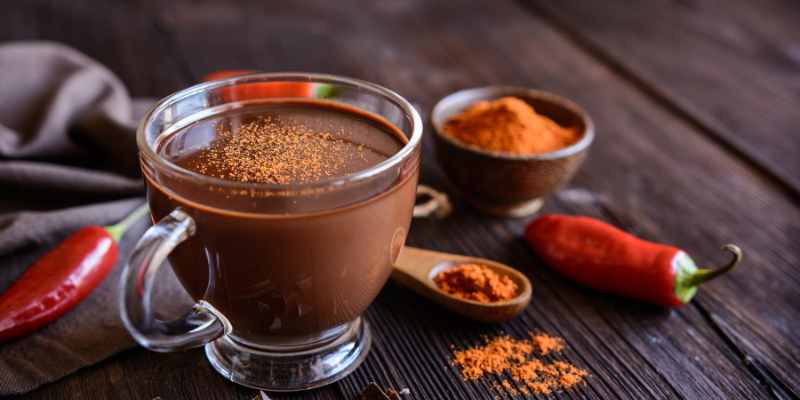
































Comments